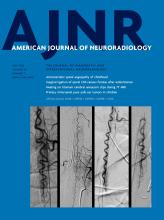Review ArticleBrain Tumor Imaging
Open Access
The 2021 World Health Organization Classification of Tumors of the Central Nervous System: What Neuroradiologists Need to Know
A.G. Osborn, D.N. Louis, T.Y. Poussaint, L.L. Linscott and K.L. Salzman
American Journal of Neuroradiology July 2022, 43 (7) 928-937; DOI: https://doi.org/10.3174/ajnr.A7462
A.G. Osborn
aFrom the Department of Radiology and Imaging Sciences (A.G.O., K.L.S.), University of Utah School of Medicine, Salt Lake City, Utah
D.N. Louis
bDepartment of Pathology (D.N.L.), Massachusetts General Hospital, Harvard Medical School, Boston, Massachusetts
T.Y. Poussaint
cDepartment of Radiology (T.Y.P.), Boston Children’s Hospital, Harvard Medical School, Boston, Massachusetts
L.L. Linscott
dIntermountain Pediatric Imaging (L.L.L.), Primary Children's Hospital, University of Utah School of Medicine, Salt Lake City, Utah
K.L. Salzman
aFrom the Department of Radiology and Imaging Sciences (A.G.O., K.L.S.), University of Utah School of Medicine, Salt Lake City, Utah

References
- 1.↵
- 2.↵
- 3.↵
- 4.↵
- 5.↵
- 6.↵
- 7.↵
- 8.↵
- 9.↵
- 10.↵
- 11.↵WHO Classification of Tumours Editorial Board. World Health Organization Classification of Tumours of the Central Nervous System. 5th ed: Lyon: International Agency for Research on Cancer; 2021
- 12.↵
- Batchala PP,
- Muttikkal TJ,
- Donahue JH, et al
- 13.↵
- Patel SH,
- Poisson LM,
- Brat DJ, et al
- 14.↵
- 15.↵
- 16.↵
- Benson JC,
- Summerfield D,
- Carr C, et al
- 17.↵
- 18.↵
- 19.↵
- 20.↵
- 21.↵
- Aboian MS,
- Solomon DA,
- Felton E, et al
- 22.↵
- 23.↵
- 24.↵
- 25.↵
- 26.↵
- 27.↵
- Deng MY,
- Sill M,
- Sturm D, et al
- 28.↵
- 29.↵
- 30.↵
- 31.↵
- Nunes RH,
- Hsu CC,
- da Rocha AJ, et al
- 32.↵
- Lecler A,
- Bailleux J,
- Carsin B, et al
- 33.↵
- Kupp R,
- Ruff L,
- Terranova S, et al
- 34.↵
- 35.↵
- Witt H,
- Mack SC,
- Ryzhova M, et al
- 36.↵
- 37.↵
- 38.↵
- 39.↵
- 40.↵
- 41.↵
- 42.↵
- 43.↵
- 44.↵
- 45.↵
- 46.↵
In this issue
American Journal of Neuroradiology
Vol. 43, Issue 7
1 Jul 2022
Advertisement
A.G. Osborn, D.N. Louis, T.Y. Poussaint, L.L. Linscott, K.L. Salzman
The 2021 World Health Organization Classification of Tumors of the Central Nervous System: What Neuroradiologists Need to Know
American Journal of Neuroradiology Jul 2022, 43 (7) 928-937; DOI: 10.3174/ajnr.A7462
0 Responses
Jump to section
Related Articles
- No related articles found.
Cited By...
- Mesenchymal Nonmeningothelial Tumors of the CNS: Evolving Molecular Landscape and Implications for Neuroradiologists
- Ependymal Tumors: Overview of the Recent World Health Organization Histopathologic and Genetic Updates with an Imaging Characteristic
- High-Grade Astrocytoma with Piloid Features: A Dual Institutional Review of Imaging Findings of a Novel Entity
- Theranostics in Neurooncology: Heading Toward New Horizons
- Modeling Glioma Oncostreams In Vitro: Spatiotemporal Dynamics of their Formation, Stability, and Disassembly
- Comparison of the Diagnostic Performance from Patients Medical History and Imaging Findings between GPT-4 based ChatGPT and Radiologists in Challenging Neuroradiology Cases
- PiDeeL: Pathway-Informed Deep Learning Model for Survival Analysis and Pathological Classification of Gliomas
- Newly Recognized CNS Tumors in the 2021 World Health Organization Classification: Imaging Overview with Histopathologic and Genetic Correlation
- Amino Acid Tracer PET MRI in Glioma Management: What a Neuroradiologist Needs to Know
- Increasing Ciliary ARL13B Expression Drives Active and Inhibitor-Resistant SMO and GLI into Glioma Primary Cilia
This article has not yet been cited by articles in journals that are participating in Crossref Cited-by Linking.
More in this TOC Section
Similar Articles
Advertisement











